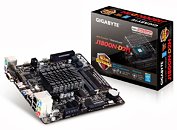Monday, February 3rd 2014

Gigabyte Outs the J1800N-D2H Mini-ITX Motherboard
Joining Biostar with its Celeron J1800-based motherboard is Gigabyte, with the J1800N-D2H. The SoC features a dual-core 64-bit x86 CPU clocked up to 2.53 GHz, wired to a pair of DDR3 SO-DIMM slots, a PCI-Express 2.0 x1 slot, and a mini PCI-Express card slot. Display connectivity includes HDMI and D-Sub. Two SATA 3 Gb/s ports, a USB 3.0 port, four USB 2.0 ports, gigabit Ethernet, and PS/2 mouse/keyboard ports make for the rest of the connectivity. Gigabyte didn't reveal pricing details.
Source:
FanlessTech

19 Comments on Gigabyte Outs the J1800N-D2H Mini-ITX Motherboard
I get the purpose, but its about 2 years late to this party and drunk. RaspberryPi, and many other companies are embracing much smaller thin form clients that offer decent performance, for much less. RBPi + 32GB card, case, and accessories only cost as much as this board combo, that still needs a case, PSU, drive, memory, and accessories.
Raspberry pi would be great with 2 or more sata ports but finding an arm based board with sata is like finding hens teeth.
i use mine to make a smart tv with my 32" toshiba, well its rather usable and fun to toy with
So what can a low speed celeron do that either a better performance desktop that cost marginally more or the raspberry pi cannot for less?
Hard drives these days are at least 100MiB/s sequential read which is 800Mbps not counting any overhead. Gigabit ethernet is where it's at. Once you go gigabit you never go back.
The whole point of these smaller thin clients is more transparency between you and your media, its a lot easier to velcro a Pi behind your TV and use it to stream your media at a few Mb per second than it is to copy to watch, copy, copy, copy.....
I can MLC my phone to my TV and play GTA3, GTA:SA on it, stream music, my videos, internet videos (although netflix still looks bad and they should feel bad), and it works fine. My point is this device/idea is and was obsolete when the idea sprang to life. They may sell some to people for toys, and if some company IT guy has a hard on for them the unlucky workers may get a underpowered cubicle warmer. Phones and pads are already as powerful and fast, and are significantly more versatile, other devices that are more powerful don't cost so much more to make this a reasonable option, so I am not sure where and what its for unless a very, very, very niche market.
Less than $100 to get a mobo/Richland FM2 setup with way more features, all the same components will still be required.
Gig connection plus dual band wifi, print server, and more?
Any video with advanced options? Comparing image quality between real time CPU enabled filters and GPU hardware acceleration and filters the CPU loses. But again, here we are at the dividing line for price/features/performance of the device where you get to choose one with it, VS perhaps $20 more for two, or even all three.
About the videos I was talking about H.264 files on the Internet that are encoded with options(for example high ref frames) that don't play well with hardware decoders as they're less flexible than even dxva or cuvid. Pair that up with audio that can't be bitstreamed like dts-hd ma or flac and stylized subtitles and you would be looking at a slide show without a decent cpu.
Second post, so again, AMD A4 plus cheap board for the same price, with more hardware features including DTS-HD and multiple rendering with hardware acceleration and filters........
And again, what then is the point of this setup other than Intel stuffing it on companies as a way to get rid of otherwise useless chips.